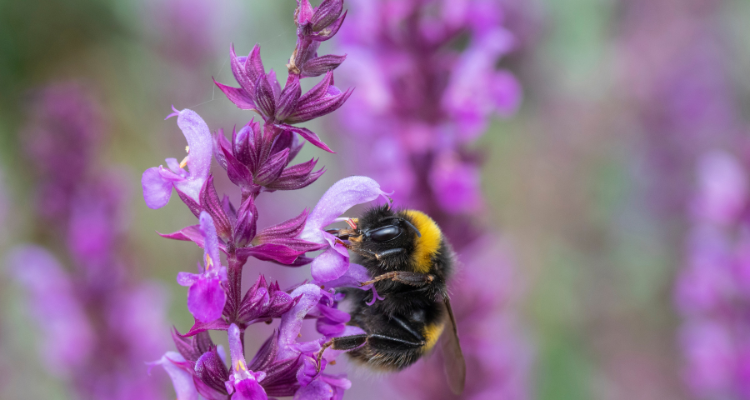
What We've Included
When to Plant | How to Plant | Where to Plant | After Care | Propagating |
Common Issues | When do they Flower | Inspiration
When to Plant Salvia
Salvias can be planted from April to early June, when the ground is most pliable. If you purchase a Salvia in autumn, keep it in a pot somewhere frost-free and cool until you can plant them out in spring.

How to Plant Salvia
Planting Loose Rooted Salvia
Loose roots to beginners might sound intimidating but are really easy to plant! Here’s how to do it:
- Soak roots in a bucket of water for 1-2 hours before planting.
- Dig a hole in the border that’s big enough to house the root system. If planting in pots, fill it halfway with potting soil and then pop the roots in with the crown pointing upwards and the root system pointing to the floor.
- Plant in groups for a fuller display, usually in groups of 3, somewhere that gets plenty of sunlight.
- Ensure the crown is just below the soil unless the plant has some leaves, in which case leave them exposed with the rest of the root system under the soil.
- Water well once planted.
Planting Pot-Grown Plants or Modules
Pot-grown plants are another easy way to plant and grow your favourite plants. Whether you’re growing them directly outside into the border or into a container, our pot-grown plants are a breeze from the moment they arrive.
- Dig a hole in the border that’s big enough to house the root system. If planting in pots, fill a large pot halfway with potting soil and then make a well in the middle. Do this until the top of the soil from the plant is just below the top of the pot.
- Ensure the root ball is planted as deep as it was in its pot.
- Wedge in the plant by adding soil to the gaps in the hole, firming down the surface to ensure it’s in place. - Water well and you’re done!
Where to Plant Salvia
Salvia isn’t a fussy plant and can be grown in less-than-ideal soil conditions. Ensure the soil is well-drained, especially if your garden soil leans more on the clay side. This can be fixed though – simply add horticultural grit to the bottom of the planting hole before the plant to help with drainage. Ensure its growing spot gets plenty of sunlight. Try not to waterlog the soil they’re sitting in, as it can cause them to die back.

After Care
When to water Salvia
Salvias grown in pots will need regular watering. Border salvias should get enough water from rainfall, as they are highly drought-tolerant plants once they’ve been established.
How to Feed Salvia
Salvias grown in borders don’t need feeding as they get all their nutrients from the ground - feeding salvias will make them grow more leaves than blooms, so it will be counterproductive. Varieties grown in containers will prefer a high potash tomato feed in spring and early autumn, as the soil won’t have access to the same nutrients that borders will offer.
Overwintering
In autumn, remove faded heads and apply a generous amount of mulch around the base of the plant to keep it warm over winter. In cold areas, lift your salvias like you would a dahlia, storing them overwinter in pots indoors.
Deadheading
You can deadhead the flowers on your salvia if you’d like to keep the display looking tidy.
Propagating Salvia
The best way to propagate Salvia is to take cuttings in summer.
Side shoots make the best cuttings, as long as they don’t have a flower on the end. Take a cutting of the side shoot at the base and pop them in a small bag (this retains moisture).
Cuttings will root easily, establish well, and you can pot them on in spring without needing to buy a new plant.
How to pot up a Salvia cutting:
- Add grit to the bottom of a small pot, along with potting up soil.
- Take all leaves off (leaving two at the top) with a sharp knife, as it’ll stop the cutting from drying out.
- In the small pot, place the cutting against the edge of the pot rather than in the middle. This seems to be the ideal positioning for a cutting to take root.
- Water thoroughly in a well-lit area, but not in direct sunlight.
- Ensure the soil is kept relatively moist, but not sopping.
- Plant out in spring.
Common Issues and How to Solve Them
Salvia is typically a pest-free plant. You may experience some challenges in winter, as Salvias don’t enjoy cold or wet conditions. Plants positioned in clay soil may die. If your salvia is showing no signs of growth in mid-June, then it’s likely it has died.
When Do Salvia Flower?
Salvia will produce flowers anytime between June and November.

Ready to Shop?
Find some inspiration for your garden
